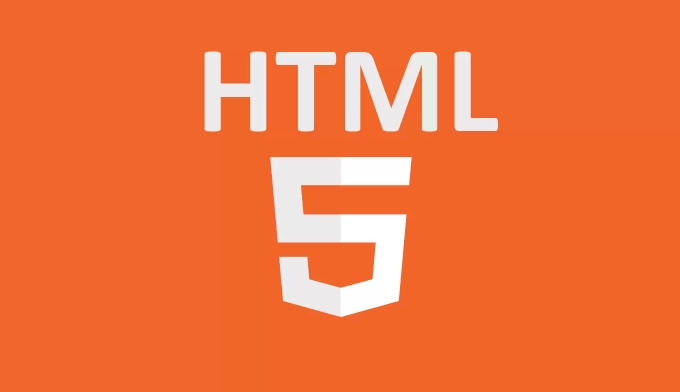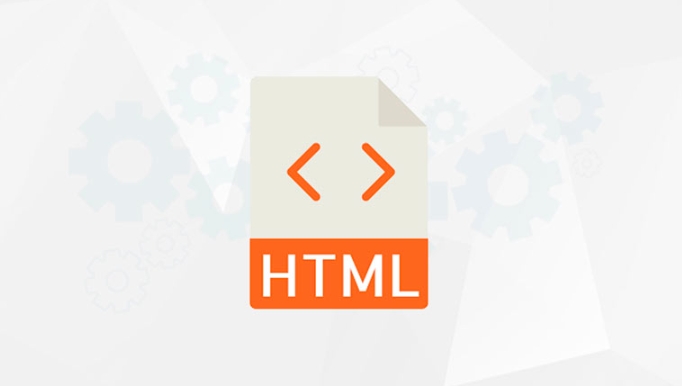To handle HTML errors, you need to start from four aspects: structural specification, resource loading, form verification and compatibility. 1. Use effective structure to ensure that the tag is closed and the semantics are correct, and avoid misalignment; 2. Add alt attribute to the picture and set an error fallback scheme to monitor the failure of resource loading; 3. Use required and pattern attributes to perform form verification, and at the same time the backend is validated again, combining JS to improve the experience; 4. Use progressive enhancement strategies to provide fallback content, and test the performance of mainstream browsers. Use polyfill to be compatible with the old environment if necessary.

Handling HTML errors does not actually have a clear try-catch mechanism like writing JavaScript, but it does not mean that it is not important. Common errors in HTML pages include unclosed tags, confusing structures, failed reference resources, etc. These problems may cause abnormal page rendering or affect SEO. The following is a few practical perspectives to talk about how to better deal with possible problems in HTML.

Using a valid HTML structure
This is the most basic and easiest point to be overlooked. A well-structured and semantic HTML page can not only improve accessibility, but also reduce the probability of errors in browser parsing.
- Make sure the tags appear in pairs : for example,
<div> should have corresponding <code>
<header></header> , <main></main> , <footer></footer> , etc., which help browsers and auxiliary tools correctly identify content structure.<div> in the <code><p></p> tag, otherwise <p></p> may be automatically disconnected in some browsers, causing unexpected behavior.A good way to verify HTML is to use W3C's HTML Validator , throw your page in and run it, and it will tell you where it doesn't comply with the specification.

Handling of failed loading of pictures and external resources
Image path errors and CDN resources are common, especially in the production environment after deployment, it is easy to expose problems.
- Add
altattribute to the image : This way, even if the image fails to load, the user can know what the image should display. - Use
onerrorto fall back to the default graph (for inline) :
<img src="/static/imghw/default1.png" data-src="image.jpg" class="lazy" alt="descriptive text" oneerror="this.src='fallback.jpg';">
- CSS background image can be backed up using
background-imagesolution , or a default background color/pattern can be set as a guarantee.
In addition, if the monitoring resource fails to load, you can do some log reporting through JS to facilitate subsequent troubleshooting.

Handle common errors in form submissions
Although HTML5 already comes with some form verification functions (such as required , type="email" ), these are only front-end checks and cannot be completely relied on.
- Add
requiredattributes to each input field to avoid missing critical information. - Use
patternattribute reasonably for format verification , such as phone number, zip code, etc.:
<input type="text" pattern="\d{6}" title="Please enter the 6-digit zip code">- The backend must verify the data legitimacy again , because frontend verification can be bypassed.
For more complex scenarios, it is recommended to combine JavaScript to perform custom prompts or asynchronous verification to improve user experience.
Browser compatibility and downgrade strategies
Different browsers have slightly different levels of support for HTML, especially older browsers (such as IE).
- Use progressive enhancement strategies : first ensure basic functions are available, then add advanced features.
- Provide fallback content : for example, use
<noscript></noscript>to wrap alternative content when there is no JS. - Test the performance of mainstream browsers : Chrome, Firefox, Safari and mobile browsers must all be covered.
Some new features (such as <dialog></dialog> ) are not supported in old browsers. At this time, you can use polyfill or fallback to the general div JS implementation.
Basically that's it. HTML error handling is not something that can be achieved overnight. The key is to develop good coding habits and cooperate with verification tools and actual testing to find problems. Many problems may seem small, but they will affect the overall experience when accumulated.
The above is the detailed content of HTML Error Handling Techniques. For more information, please follow other related articles on the PHP Chinese website!

Hot AI Tools

Undress AI Tool
Undress images for free

Undresser.AI Undress
AI-powered app for creating realistic nude photos

AI Clothes Remover
Online AI tool for removing clothes from photos.

Clothoff.io
AI clothes remover

Video Face Swap
Swap faces in any video effortlessly with our completely free AI face swap tool!

Hot Article

Hot Tools

Notepad++7.3.1
Easy-to-use and free code editor

SublimeText3 Chinese version
Chinese version, very easy to use

Zend Studio 13.0.1
Powerful PHP integrated development environment

Dreamweaver CS6
Visual web development tools

SublimeText3 Mac version
God-level code editing software (SublimeText3)
 Applying Semantic Structure with article, section, and aside in HTML
Jul 05, 2025 am 02:03 AM
Applying Semantic Structure with article, section, and aside in HTML
Jul 05, 2025 am 02:03 AM
The rational use of semantic tags in HTML can improve page structure clarity, accessibility and SEO effects. 1. Used for independent content blocks, such as blog posts or comments, it must be self-contained; 2. Used for classification related content, usually including titles, and is suitable for different modules of the page; 3. Used for auxiliary information related to the main content but not core, such as sidebar recommendations or author profiles. In actual development, labels should be combined and other, avoid excessive nesting, keep the structure simple, and verify the rationality of the structure through developer tools.
 Implementing Clickable Buttons Using the HTML button Element
Jul 07, 2025 am 02:31 AM
Implementing Clickable Buttons Using the HTML button Element
Jul 07, 2025 am 02:31 AM
To use HTML button elements to achieve clickable buttons, you must first master its basic usage and common precautions. 1. Create buttons with tags and define behaviors through type attributes (such as button, submit, reset), which is submitted by default; 2. Add interactive functions through JavaScript, which can be written inline or bind event listeners through ID to improve maintenance; 3. Use CSS to customize styles, including background color, border, rounded corners and hover/active status effects to enhance user experience; 4. Pay attention to common problems: make sure that the disabled attribute is not enabled, JS events are correctly bound, layout occlusion, and use the help of developer tools to troubleshoot exceptions. Master this
 Configuring Document Metadata Within the HTML head Element
Jul 09, 2025 am 02:30 AM
Configuring Document Metadata Within the HTML head Element
Jul 09, 2025 am 02:30 AM
Metadata in HTMLhead is crucial for SEO, social sharing, and browser behavior. 1. Set the page title and description, use and keep it concise and unique; 2. Add OpenGraph and Twitter card information to optimize social sharing effects, pay attention to the image size and use debugging tools to test; 3. Define the character set and viewport settings to ensure multi-language support is adapted to the mobile terminal; 4. Optional tags such as author copyright, robots control and canonical prevent duplicate content should also be configured reasonably.
 Best HTML tutorial for beginners in 2025
Jul 08, 2025 am 12:25 AM
Best HTML tutorial for beginners in 2025
Jul 08, 2025 am 12:25 AM
TolearnHTMLin2025,chooseatutorialthatbalanceshands-onpracticewithmodernstandardsandintegratesCSSandJavaScriptbasics.1.Prioritizehands-onlearningwithstep-by-stepprojectslikebuildingapersonalprofileorbloglayout.2.EnsureitcoversmodernHTMLelementssuchas,
 HTML for email templates tutorial
Jul 10, 2025 pm 02:01 PM
HTML for email templates tutorial
Jul 10, 2025 pm 02:01 PM
How to make HTML mail templates with good compatibility? First, you need to build a structure with tables to avoid using div flex or grid layout; secondly, all styles must be inlined and cannot rely on external CSS; then the picture should be added with alt description and use a public URL, and the buttons should be simulated with a table or td with background color; finally, you must test and adjust the details on multiple clients.
 How to associate captions with images or media using the html figure and figcaption elements?
Jul 07, 2025 am 02:30 AM
How to associate captions with images or media using the html figure and figcaption elements?
Jul 07, 2025 am 02:30 AM
Using HTML sums allows for intuitive and semantic clarity to add caption text to images or media. 1. Used to wrap independent media content, such as pictures, videos or code blocks; 2. It is placed as its explanatory text, and can be located above or below the media; 3. They not only improve the clarity of the page structure, but also enhance accessibility and SEO effect; 4. When using it, you should pay attention to avoid abuse, and apply to content that needs to be emphasized and accompanied by description, rather than ordinary decorative pictures; 5. The alt attribute that cannot be ignored, which is different from figcaption; 6. The figcaption is flexible and can be placed at the top or bottom of the figure as needed. Using these two tags correctly helps to build semantic and easy to understand web content.
 What are the most commonly used global attributes in html?
Jul 10, 2025 am 10:58 AM
What are the most commonly used global attributes in html?
Jul 10, 2025 am 10:58 AM
class, id, style, data-, and title are the most commonly used global attributes in HTML. class is used to specify one or more class names to facilitate style setting and JavaScript operations; id provides unique identifiers for elements, suitable for anchor jumps and JavaScript control; style allows for inline styles to be added, suitable for temporary debugging but not recommended for large-scale use; data-properties are used to store custom data, which is convenient for front-end and back-end interaction; title is used to add mouseover prompts, but its style and behavior are limited by the browser. Reasonable selection of these attributes can improve development efficiency and user experience.
 How to handle forms submission in HTML without a server?
Jul 09, 2025 am 01:14 AM
How to handle forms submission in HTML without a server?
Jul 09, 2025 am 01:14 AM
When there is no backend server, HTML form submission can still be processed through front-end technology or third-party services. Specific methods include: 1. Use JavaScript to intercept form submissions to achieve input verification and user feedback, but the data will not be persisted; 2. Use third-party serverless form services such as Formspree to collect data and provide email notification and redirection functions; 3. Use localStorage to store temporary client data, which is suitable for saving user preferences or managing single-page application status, but is not suitable for long-term storage of sensitive information.






